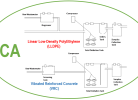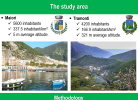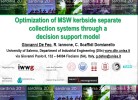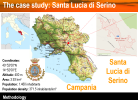LCA OF THE MANAGEMENT AND TRANSPORTATION OF MATERIALS PRODUCED WITH THE SEPARATED COLLECTION: THE CASE STUDY OF BARONISSI, ITALY
G. DE FEO*, C. IULIANO*, A. GROSSO**
* Department of Industrial Engineering (DIIN), University of Salerno, via Giovanni Paolo II 132, 84084 Fisciano (Sa), Italy
** Agenzia Regionale per la Protezione dell’Ambiente della Campania, Via Vicinale Santa Maria del Pianto, Centro Polifunzionale, Torre n. 1, 80143 Naples, Italy.
Key words: LCA, management, materials, separated collection, transportation

LCA OF THE MANAGEMENT AND TRANSPORTATION OF MATERIALS PRODUCED WITH THE SEPARATED COLLECTION: THE CASE STUDY OF BARONISSI, ITALY
The main aim of this study was to evaluate the environmental impacts of the life cycle of the management system of the materials produced with the separated collection in Baronissi, a town of 17,000 inhabitants in the Province of Salerno, in the Campania region of Italy.
The life cycle assessment (LCA) took into account the level of separated collection, the location of treatment and disposal facilities, the management of the collection program and the transportation of the collected materials inside (performed with a separate kerbside collection system) and outside the town (transportation toward the facilities). Three scenarios were considered: (1) management scenario 2000-2013; (2) management, internal and external transportation scenario 2013; (3) alternative scenario 2013 (3). SimaPro v.8.0.2 was the LCA software tool. The environmental impacts were evaluated in terms of IPCC 2007 GWP 100y, Ecological Footprint and Recipe 2008.
For all the impact assessment methods there was a continuous increasing of avoided impacts from 2000 (i.e. with no separate collection) up to 2013 (> 75% of separated collection). In particular, 175 kgCO2/cap/year was the per capita avoided impact in 2013 in terms of carbon footprint compared to the baseline year 2000. The Ecological Footprint trend was very similar to the carbon footprint. The impact category “Resources” showed the greatest influence on the result of Recipe 2008 at the endpoint level. The system boundary of Scenario 2 was extended to the final destination of all the collected materials, considering both internal and external transportation. For all the impact assessment methods, the management phase corresponded to avoided impacts, whilst the transportation phases generated positive impacts. In terms of Carbon Footprint, the following results were obtained: -135.64 kgCO2/cap/year for the management phase, +25.91 kgCO2/cap/year for the collection of materials, and +13.30 kgCO2/cap/year for external transportation. For all the methods, the internal transportation were two times more impacting than the external transportation.
The management of 11 materials (out of 18) produced positive impacts, but they were overtaken by the avoided impacts of the other materials, mainly by those related to the management of metals: 67%, 60% and 64% were the percentage incidences of metals on the total impacts of management for IPCC 2007 100y, Ecological Footprint and Recipe 2008, respectively. The transportation of putrescibles was the most impacting category for all the methods. The putrescible incidence on the total impact due to the transportation of all materials were 35% for the internal transportation, 47% for transportation to the transfer station, and 69% for the transportation to the composting plant (average distance of 500 km). Glass transportation showed a significant impact (more than 15%) due to the distance of treatment facilities (620 km), as well.
Scenario 3 differs from Scenario 2 for the presence of a composting plant at 10 km far from the town of Baronissi, without a transfer station. The proximity of a composting plant would allow saving more than 8 kg of CO2 equivalents per capita. Analogously, in terms of Ecological Footprint a saving of 22 m2*year/inhabitant would be reached.







